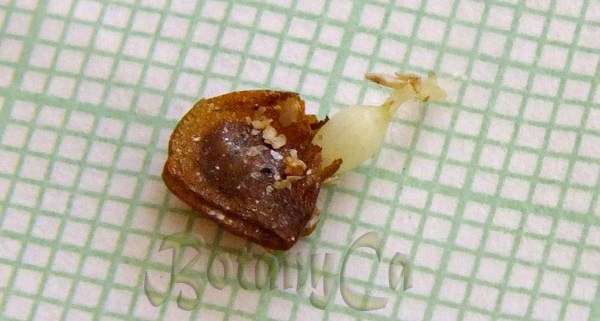Warm lilies
Lilium michiganense, Lilium canadense (plus few others) are the kind of lilies that require warmth for the first stage of germination (about 20˚C), and then a period of cold (0-5˚C for 2-3 months) for the true leaves to emerge. If you get these seeds in late fall or winter, this is the tried recipe to make sure that they’ll start growing leaves in the spring:
Place the seeds in a Ziploc bag with moist vermiculite and keep them during the winter months (Nov/Dec.-Feb/March) at room temperature. Check the moisture once in a while. After the tiny bulblets appear, place the Ziplocs in the fridge for the cold treatment (March-May). Pot them afterwards and place outside.
These bulblets had their photos taken and now are ready to switch places in the fridge with the seeds that are coming out for sowing. Some grow out of the seed and are visible, while some can remain more or less enclosed.
And bulblets of another woodland edge growing, tall Lilium (supposedly canadense); we didn’t catch it in flower last year, but it was an impressive exemplar. It has been placed on the ‘watch list’ for this year so we can properly identify it.
Although North American native species, these Liliums and also few others are almost never grown by commercial nurseries. Start growing your own, besides being ‘hot’ plants, they are pollinated by hummingbirds, sphinx moths and butterflies like the Monarch and Spicebush Swallowtail!












I love these species lilies, just lovely!
Thanks; interesting that they seem to be available more in Europe than in their land of origin ;)
I keep trying to grow the L. canadense…..I get nice seedlings and then either the chipmunks get them or the lily leaf beetles get them!
There is very little one can do about both ‘pests’…They are easily attracted to other liliums too.
I assumed it was L. canadense but until I see the buds this year cannot tell for sure; an outstanding plant for part-shade anyway.
It’s wonderful seeing your detailed pictures of the seeds. You inspire me to try more experiments with the seeding process.
Thank you. I am also inspired by others ;) and encouraged by the interest showed in growing plants from seeds!
I believe the common name for this is “Turk’s Cap”. I have a bunch of this growing near my tulips and peonies. They are very cold hardy and a perennial. Under the flower you can see black little specks or balls, which I presume are seed. A lesson I have learned about seed germination is the larger seeds tend to be easier to germinate, and also the tropical ones are easy to germinate too. These are dubbed “uncommon” in my state and I am proud that I have them growing wild! A plant that keeps pests away is the Castor plant, cheap and easy to germinate!
I hate to disappoint you but the North American native lilies don’t form axillary bulbils (“the black little specks”); this is the easiest way to distinguish them from other lilies, mainly Lilium lancifolium, which I assume you have.
This is a cultivated Chinese lily that have escape from cultivation a long time ago. It is very hardy and easy to propagate from those bulbils, reason why has become naturalized in some regions.
Also, if you would try a large number of species you’ll notice that larger seeds are not always easy to germinate; there is no direct relation between the seed size and germination.